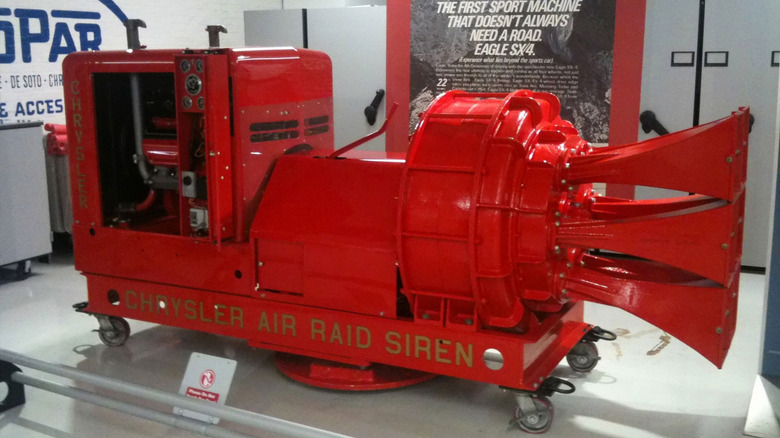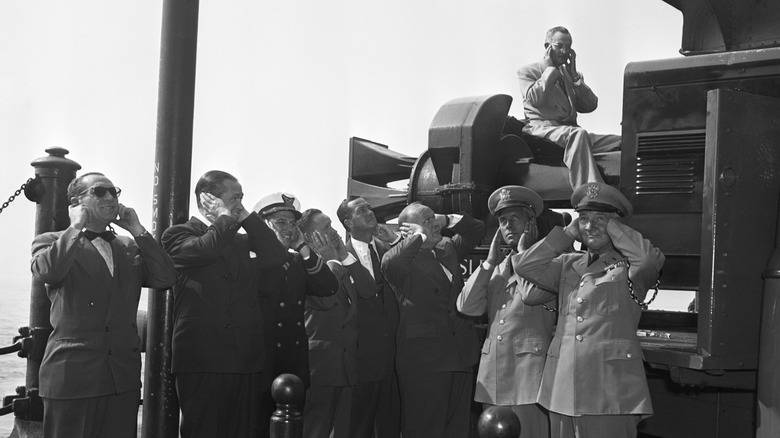The Loudest Air-Raid Sirens Ever Made Are HEMI-Powered (And Your City May Have One)
Perhaps one of the most iconic and memorable but simultaneously terrifying memories of 1950s America was the fear of nuclear disaster. Referred to as mutually assured destruction, the looming prospect of all-out nuclear warfare was ever-present among Americans and the people of the USSR. As a result, many systems were developed to survive a nuclear bomb, and perhaps none were more iconic or memorable than the incredibly loud air raid sirens used for drills.
Although you wouldn't be alone in believing that the air-raid sirens used in the 1950s no longer exist, these devices still reside in a lot of major cities across the United States — either as dormant relics of the past or kept by museums and collectors. What may be even more surprising, however, is that these massive noise-making behemoths were powered by Chrysler HEMI engines.
The Chrysler Air Raid Siren was a hulking beast that was 12-feet long, six-feet high, and weighed somewhere around 6,000 pounds. Inside the siren was a 1952 180-hp V8 Chrysler HEMI engine capable of producing an ear-shattering 138 decibels at a distance of 100 feet — nearly the same volume as a jet engine at the same distance, according to Yale.
[Featured image by User PBMI via Wikimedia Commons | Cropped and scaled | CC BY 3.0]
The HEMI-Powered Chrysler Air Raid Siren was the loudest ever
Capable of discharging 2,610 feet of air per minute at 7 PSI, the impressive Chrysler Air Raid Siren was powerful enough to blast birds from the sky and was at one point used by the military to move fog. The inline HEMI engine had a two-stage air compressor with a rotating chopper that pushed the air through horns. When the chopper sliced the air being output by the engine, it created pulses that created the unique and iconic sound. You can hear those choppers start in the video above.
Earlier designs of the siren were originally called the Chrysler-Bell Victory Siren and were produced in the 1940s during World War II. Sold across the United States, these variations used weaker engines, with the boost in power coming in 1952 — shortly following the release of the first generation HEMI a year prior, the 331-cubic-inch FirePower.
San Antonio purchased five sirens for $20,000 in the '40s (over $380K adjusted for inflation) and was disappointed with the initial variations. Earlier iterations of the siren were only capable of providing an auditory radius of eight to 10 square miles in comparison with the 1950s model using the HEMI, which was able to cover an area of around 16 square miles.
What happened to the Chrysler Air Raid Siren?
In terms of the actual physical Chrysler Air Raid Sirens, there is a niche community online with one user named Brendan Williamson who has gathered old newspaper clippings, sightings, and museum press releases to compile a map of all the Chrysler Sirens that still exist. In total, there appears to have been somewhere around 108 total documented sightings or installations of the Chrysler Air Raid Sirens at some point across the continental United States — though the total number of the actual sirens once installed likely far exceeds that.
In total, Chrysler's books claim that 350 Chrysler Air Raid Sirens were produced. Cities where the Chrysler Air Raid Siren was installed include Los Angeles, Chicago, New York, and Miami. As of the last few years, Chrysler Air Raid Sirens still exist in seven total cities, including Greenville, Seattle (which has two), Rochester, Kansas City, Compton, March Air Force Base, and Ocala, Florida, according to the community map. Important to note that some may have already been removed, and the rest will likely remain dormant. One used to be displayed at the Walter P Chrysler Museum, which permanently closed in 2016.
Today, modern alert systems use a variety of more technologically advanced systems to alert citizens of impending disasters. A combination of digital precautionary measures now prove more effective, like Wireless Emergency Alerts (WEAs) or the Emergency Alert System (EAS) on your television. That said, although the tech was predominately used decades ago, it doesn't mean sirens are gone forever. Today, alert sirens are part of what is called the Integrated Public Alert and Warning System (IPAWS) and also include things like digital billboards and NOAA weather radios.

